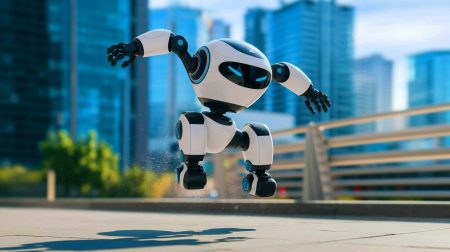| IN A NUTSHELL |
|
In a groundbreaking leap for robotics, Clone Robotics has introduced Protoclone, the world’s first synthetic android engineered to closely replicate human anatomy. Unlike previous humanoid robots, Protoclone mimics the human skeletal, muscular, vascular, and nervous systems with remarkable precision. This achievement marks a significant milestone in biomimetic technology, capturing the curiosity and fascination of both the scientific community and the general public. As the world stands on the brink of a new era in robotics, the implications of such advanced humanoid technology are both exciting and thought-provoking.
Revolutionizing Robotics: The Muscle-Powered Android
Protoclone stands as a testament to the advancements in robotic technology. This bipedal, musculoskeletal android is showcased suspended in a workshop, demonstrating dynamic movements with a face obscured by a reflective mask. Unlike its predecessors, Protoclone operates using pneumatic systems, although future versions are expected to transition to hydraulics for greater efficiency and performance. The android’s design is a unique blend of human-like skeletal, muscular, and nervous systems, crafted from synthetic components to emulate biological functions.
Clone Robotics asserts that Protoclone is the first of its kind—a full musculoskeletal android intended for commercial use, setting it apart from Japan’s JSK Lab’s Kengoro, which was developed for research purposes. Founded in 2021, Clone Robotics has focused on biomimetic robotics, aiming to emulate the strength and dexterity of living organisms. Unlike companies such as Tesla, which create robots for domestic tasks, Clone targets the complexities of human-like capabilities, addressing challenges of anatomical accuracy and movement with advanced artificial muscle and skeletal systems.
The Anatomy of Innovation: Human-like Structure
Protoclone’s construction is based on an intricate human skeletal framework, encompassing all 206 bones and featuring sophisticated joint articulation with synthetic ligaments and connective tissues. The android’s advanced mobility is propelled by Clone’s proprietary Myofiber artificial muscle technology. Each Myofiber serves as a monolithic musculotendon unit, designed to replicate natural muscle function by attaching to anatomically accurate points on the skeleton, thereby minimizing tendon failure risks.
The Myofibers are engineered to emulate mammalian muscle properties, capable of responding in under 50 milliseconds, contracting over 30 percent when unloaded, and generating substantial force. With over 1,000 Myofibers, Protoclone boasts exceptional power density, speed, and energy efficiency. Its upper torso alone features 164 degrees of freedom, encompassing complex movements in the hand, wrist, elbow, shoulder joints, and spinal vertebrae.
Cutting-edge Sensory and Control Systems
Protoclone is equipped with a comprehensive sensory and control system, integrating 4 depth cameras for vision, 70 inertial sensors for joint-level proprioception, and 320 pressure sensors for muscle force feedback. This intricate network allows Protoclone to execute lifelike movements with precision. Clone Robotics employs a control architecture utilizing microcontrollers embedded along the spine and an NVIDIA Jetson Thor GPU housed in the skull, running Cybernet, a visuomotor foundation model.
The android’s vascular system operates with a compact 500-watt electric pump and Aquajet valves that distribute pressurized hydraulic fluid throughout the muscular system, facilitating realistic movement and control. This sophisticated design exemplifies the seamless integration of technology and biology, pushing the boundaries of what robotics can achieve.
The Future of Humanoid Technology
Clone Robotics’ Protoclone represents a monumental shift in how humanoid robots are perceived and developed. By closely emulating human anatomy, Protoclone opens up a plethora of possibilities for future applications, from commercial to potentially domestic uses. As this technology evolves, it raises intriguing questions about the role of androids in society and how they might reshape industries and daily life.
As we stand at the dawn of a new era in robotics, one must ponder: How will the integration of such advanced humanoid robots influence the future of human-robot interactions and the broader societal landscape?
Did you like it? 4.6/5 (28)






Wow, truly amazing! How long did it take to develop Protoclone? 🤖
Is anyone else worried about a future where androids replace human workers? 😟
I’m skeptical. Can it really mimic human emotions and interactions?
This is just like a sci-fi movie! How soon can we expect to see these androids in daily life?
Thank you for the insightful article! The future of robotics is truly fascinating. 🌟
What materials were used in the construction of Protoclone’s skeleton?